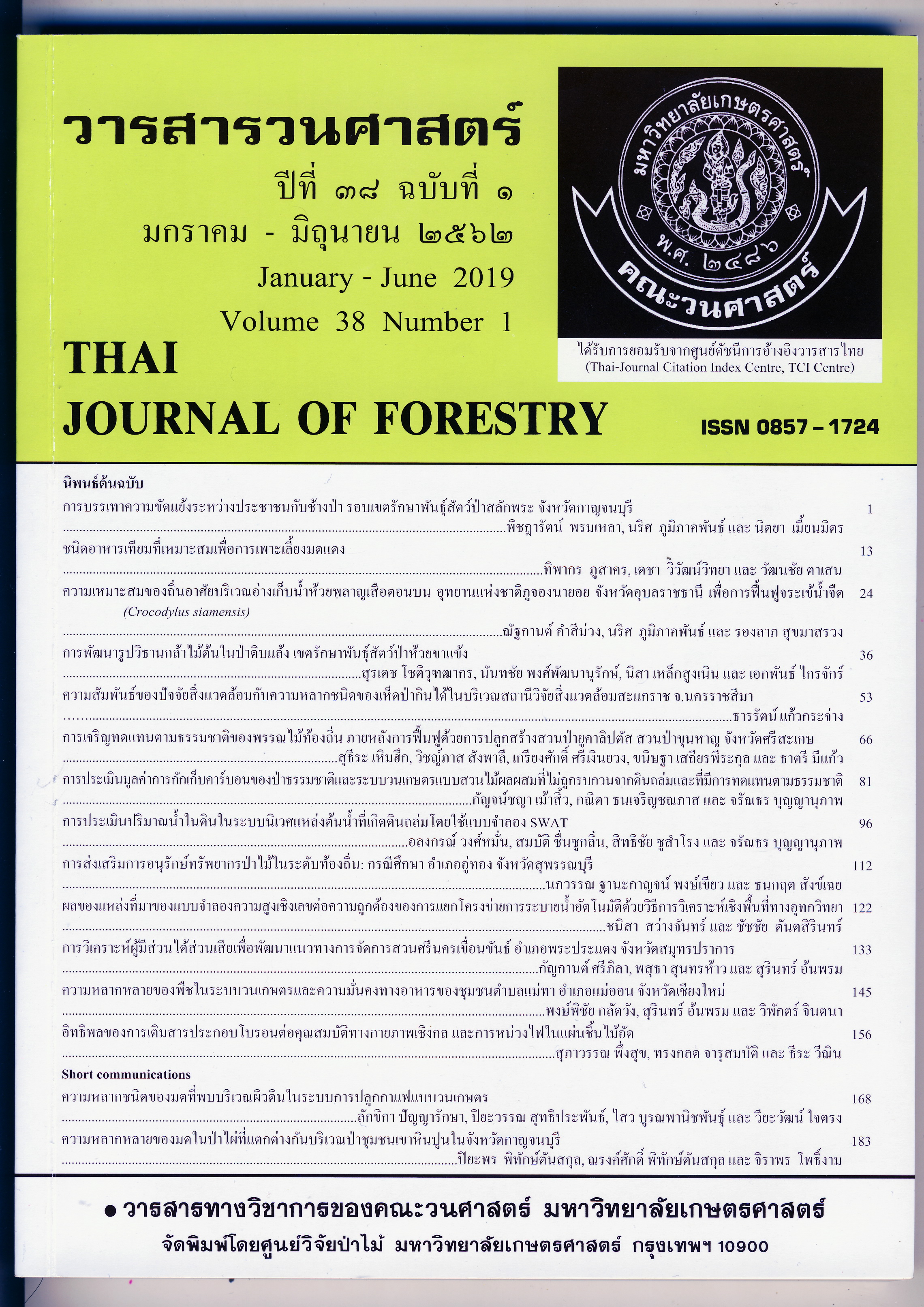ความสัมพันธ์ของปัจจัยสิ่งแวดล้อมกับความหลากชนิดของเห็ดป่ากินได้ในบริเวณ สถานีวิจัยสิ่งแวดล้อมสะแกราช จังหวัดนครราชสีมา
Main Article Content
บทคัดย่อ
จากการสำรวจเห็ดกินได้ในป่าเต็งรังและป่าดิบแล้งบริเวณสถานีวิจัยสิ่งแวดล้อมสะแกราช จ.นครราชสีมา ในช่วงเดือนมิถุนายน – ตุลาคม พ.ศ. 2560 พบเห็ดกินได้ทั้งหมด 32 ชนิด ซึ่งสามารถจัดจำแนกอยู่ใน 1 ไฟลัม (Phylum) 1 ไฟลัมย่อย (Subphylum) 3 ชั้น (Class) 8 อันดับ (Order) 11 วงศ์ (Family) 16 สกุล (Genus) โดยพบเห็ดกินได้ในป่าเต็งรังมีค่าดัชนีความหลากชนิด (29 ชนิด H’ = 2.328) สูงกว่าป่าดิบแล้ง (16 ชนิด H’ = 1.810) เห็ดที่พบส่วนใหญ่เป็นเห็ดเอคโตไมคอร์ไมคอร์ไรซา (ectomycorrhizal mushrooms) ซึ่งพบจำนวน 21 ชนิด (คิดเป็นร้อยละ 65.63) และในจำนวนเห็ดที่พบทั้งหมดพบว่าเห็ดวงศ์ Russulaceae มีความหลากชนิดมากที่สุด โดยวงศ์นี้พบเห็ดสกุล Russula 9 ชนิด และ Lactarius 2 ชนิด จากการศึกษาความสัมพันธ์ระหว่างปัจจัยแวดล้อมกับการปรากฏของเห็ดกินได้โดยใช้ Canonical Correspondence Analysis (CCA) พบว่าสามารถแบ่งกลุ่มเห็ดออกเป็น 3 กลุ่ม ประกอบด้วย กลุ่มที่ 1 กลุ่มเห็ดที่มีความสัมพันธ์เชิงบวกกับความชื้นในดิน ได้แก่ เห็ดแดงน้ำหมาก (Russula emetica) เห็ดระโงกขาว (Amanita princeps) เห็ดขมิ้นเล็ก (Craterellus aureus) เห็ดขมิ้นใหญ่ (C. odoratus) เป็นต้น กลุ่มที่ 2 กลุ่มเห็ดที่พบบริเวณที่มีอุณหภูมิอากาศและความเข้มแสงรอบวันเฉลี่ยสูง ได้แก่ เห็ดตะไคลขาว (R. delica) เห็ดถ่านเล็ก (R. densifolia) เห็ดไข่เยี่ยวม้า (A. vaginata) เป็นต้น และกลุ่มที่ 3 เห็ดที่มักพบกระจายทั่วไป ได้แก่ เห็ดน้ำแป้ง (R. alborealata) เห็ดระโงกเหลือง (A. hemibapha) เห็ดหูหนูบาง (Auricularia thailandica) เป็นต้น นอกจากนี้ยังพบว่าปริมาณมวลชีวภาพของหญ้าเพ็กมีอิทธิพลต่อความหลากชนิดของเห็ดกินได้ในป่าเต็งรัง ซึ่งหากพื้นป่ามีหญ้าเพ็กขึ้นปกคลุมหนาแน่นจนเกินไปจะส่งผลให้ปริมาณของเห็ดกินได้ลดลง
Downloads
Article Details
ข้าพเจ้าและผู้เขียนร่วม (ถ้ามี) ขอรับรองว่า ต้นฉบับที่เสนอมานี้ยังไม่เคยได้รับการตีพิมพ์และไม่ได้อยู่ในระหว่างกระบวนการพิจารณาตีพิมพ์ลงในวารสารหรือสิ่งตีพิมพ์อื่นใด ข้าพเจ้าและผู้เขียนร่วม (ถ้ามี) ยอมรับหลักเกณฑ์และเงื่อนไขการพิจารณาต้นฉบับ ทั้งยินยอมให้กองบรรณาธิการมีสิทธิ์พิจารณาและตรวจแก้ต้นฉบับได้ตามที่เห็นสมควร พร้อมนี้ขอมอบลิขสิทธิ์ผลงานที่ได้รับการตีพิมพ์ให้แก่วารสารวนศาสตร์ คณะวนศาสตร์ มหาวิทยาลัยเกษตรศาสตร์ กรณีมีการฟ้องร้องเรื่องการละเมิดลิขสิทธิ์เกี่ยวกับภาพ กราฟ ข้อความส่วนใดส่วนหนึ่ง หรือ ข้อคิดเห็นที่ปรากฏในผลงาน ให้เป็นความรับผิดชอบของข้าพเจ้าและผู้เขียนร่วม (ถ้ามี) แต่เพียงฝ่ายเดียว และหากข้าพเจ้าและผู้เขียนร่วม (ถ้ามี) ประสงค์ถอนบทความในระหว่างกระบวนการพิจารณาของทางวารสาร ข้าพเจ้าและผู้เขียนร่วม (ถ้ามี) ยินดีรับผิดชอบค่าใช้จ่ายทั้งหมดที่เกิดขึ้นในกระบวนการพิจารณาบทความนั้น”
เอกสารอ้างอิง
Mortimer, J. Xu, P. Kakumyan, and K.D.
Hyde. 2017. Diversity of Auricularia
(Auriculariaceae, Auriculariales) in Thailand.
Phytotaxa 292(1): 19-34.
Bas, C. 1969. Morphology and subdivision of Amanita
and a monograph of its section Lepidella.
Persoonia. 5(3): 285-579.
Bergemann, S. E. and D. L. Largent. 2000. The site
specific variable that correlate with the
distribution of the Pacific Gloden Chanterelle,
Cantharellus formosus. For Ecol Manag
130: 99-107.
Boa, E. 2004. Wild edible fungi. A global overview
of their use and importance to people. Non-
Wood Forest Products 17. FAO, Rome.
Chalermpongse, A. and T. Boonthavikoon. 1981.
The Investigation of Mycorrhizal Fungi
Associated with Roots of Trees in Sakaerat
Dry-Dipterocarp Forest Ecosystem. Forest
pest control branch, Royal Forest Department,
Bangkok.
______ and ______. 1982. The Investigation of
Ectomycorrhiza in Dry-Evergreen Forest
Ecosystem. Forest pest control branch, Royal
Forest Department, Bangkok.
Corner, E.L.H. 1972. Boletus in Malaysia. The
Government Printing Office, Singapore.
Dighton, J., J. M. White and P. Oudemans. 2005.
The Fungal Community. Its Organization
and Role in the Ecosystem, 3rd edn. CRC,
Boca Raton.Gao, C., N. Shi, Y. Liu, K. G. Peay, Y. Zheng, Q. Ding,
X. Mi, K. Ma, T. Wubet, F. Buscot and L.Guo. 2013.
Host plant genus-level diversityis the best predictor of ectomycorrhizal fungal
diversity in a Chinese subtropical forest.
Molecular Ecology 22: 3403–3414.
Hawksworth, D. L. and R. Lücking. 2017. Fungal
diversity revisited: 2.2 to 3.8 million species.
Microbiolspec. FUNK 52: 1-17.
Karun, N.C. and K.R. Sridhar 2013. Occurrence and
distribution of Termitomyces (Basidiomycota,
Agaricales) in the Western Ghats and on the
west coast of India. Czech Mycol. 65(2):
233–254.
Krebs, C. J. 1972. Ecology: The Experimental
Analysis of Distribution and Abundance.
Harper & Row, Publishers, INC, USA.
Kosol, S., T. Kumlung, T. Inyod, P. Thongbai, T.
Archavacom and S. Savakronburi. 2006.
Species diversity of edible mushrooms and
plants at sakaerat biosphere reserve, pp.
636-643 In Proceedings of 44th Kasetsart
University Annual Conference : Engineering,
Architecture, Natural Resources and
Environmental Management. Kasetsart
University, Bangkok.
Largent, D. L. 1977. How to Identify Mushrooms
to Genus I: Macroscopic Features. Eureka
Printing Co., Inc., Eureka.
Largent, D., D. Johnson and R. Watling. 1977.
How to Identify Mushrooms to Genus III:
Microscopic Features. Eureka Printing Co.
Inc., Eureka.
McCune, B. and M. J.Mefford. 1999. PC-ORD,
Multivariate Analysis of Ecological Data,
Version 4. MJM Software, Gleneden Beach.
Sampanpanish, P. 2000. Assessment on Biodiversity
Surveys of Plant Community at Sakaerat
Environmental Station, Nakhon Ratchasima.
Final Report, Chulalongkorn University.
Sangwanit, U., P. Suwannarit, A. Payappanon, J. Luangsaard,
A. Chandrasrikul and B. Sakolrak. 2013.
List of Mushrooms. Biodiversity-Based Economy
Development Office (Public Organization),
Bangkok.
Tanticharoen, M. 2004. Introduction to Thai biodiversity.
In E.B.G. Jones, M. Tantichareon, and K.D.
Hyde, (eds.) Thai Fungal Diversity. National
Center for Genetic Engineering and Biotechnology
(BIOTEC), Thailand, pp. 1–6.
Yorou, N. S., N. A. Kone, M. Guissou, A. K. Guelly,
D. L. Maba, M. R. M. Ekue and A.D. Kesel.
2014. Biodiversity and sustainable use of
wild edible fungi in the Sudanian centre of
endemism: a plea for Valorisation. p. 241-271.
In A. M. Bâ, K. L. McGuire, and A. G. Diédhiou
Ectomycorrhizal Symbioses in Tropical and
Neotropical Forests. CRC Press, New York.


